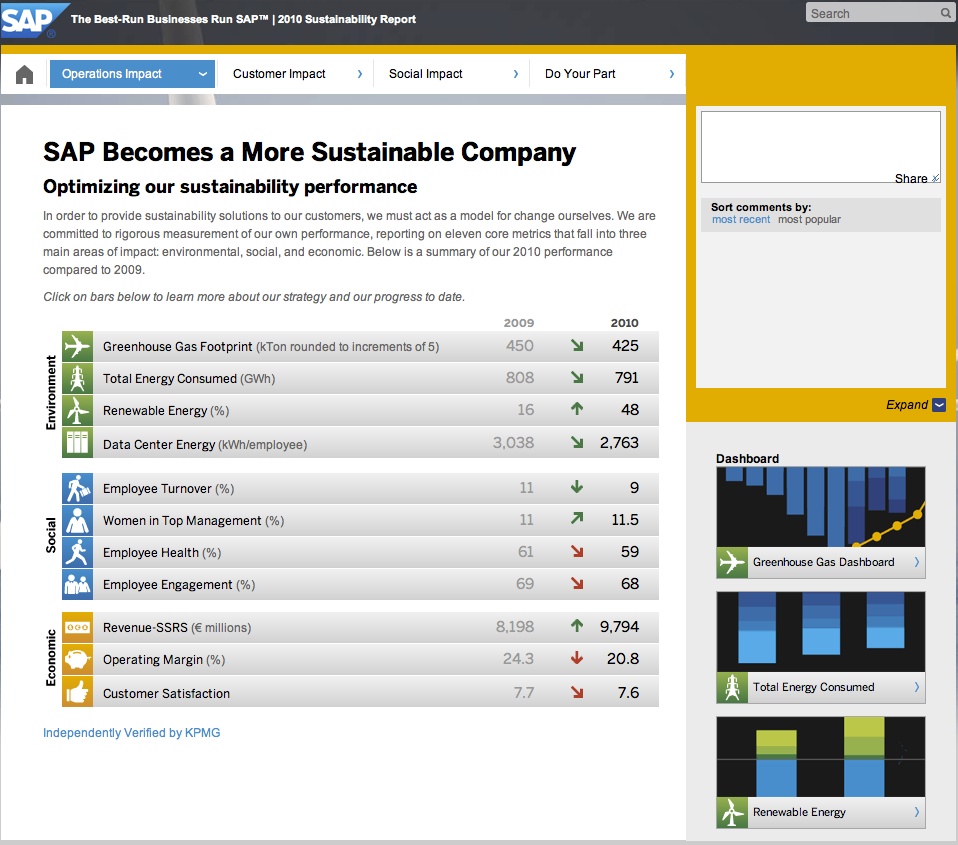SAP Sustainability Report hints at revenue opportunities

Earlier today, SAP launched its 2011 Sustainability Report. It works well as an exercise in interactive communication, melding graphical reporting with discursive content, the ability for users to select data in which they are interested and feedback to SAP on any topic item, posting those comments out to Twitter, Facebook and LinkedIn. SAP gets credit for production coolness, availability on iPad and other tablets plus the open source use of Drupal as the platform upon which the report is built. But that only scratches the surface of what is a meaty report showing progress across a number of dimensions.
In the past I have been critical of SAP's sustainability efforts. I largely saw them as little more than a way to flog more reporting aka BusinessObjects modules combined with an attention to accounting that leads to one hit cost savings. This report hints at opportunities to use the sustainability agenda to both cut costs and generate new revenues. How does this work?
Unfortunately the report doesn't reveal as much as I would like. During a discussion with Peter Graf, who leads SAP's sustainability efforts, he punched up some telling data from a presentation not included in the report regarding the energy footprint of SAP's global 188,000+ customer instances. These are sliced and diced across different dimensions such as type of instance e.g. ERP, BusinessOne etc. The most interesting slide for me covered categories of consumption. (see below)
This is where SAP's current technology investments could pay off handsomely. As the slide shows, data stores consume massive amounts of energy. Peter suggested that moving to SSD and in-memory computing could lead to significant operational savings. He added that 50% of SAP's own systems are now virtualised which in turn will cut the data center overhead.
Vinnie Mirchandani can speak to the detail on these cost line items far more eloquently than I but this simple graph does more for me than many other I have seen. Releasing cost on this scale could dramatically impact IT's ability to deliver solutions that add value, rather than fighting to keep the lights on with ever reducing budgets.
As an aside, I'd like to see CIOs and CTOs be much more aggressive in taking positions. So for example if I can promise a significant reduction in energy usage by switching technologies then how much is the business prepared to re-invest in order to develop the revenue based solutions business will need tomorrow and the next day. That should be at the heart of any sustainability argument. Going back to an argument Vinnie recently put out:
By 2012, CEOs will no longer want us drooling over every new feature Apple or Google or Facebook delivers. They will be asking where is OUR smarter infusion system, furniture, apparel and more for the Apple, Google and Facebook educated customer.
That is the big opportunity – and challenge for all of us. Revenue from technology enabled products.
Back to the revenue discussion. Peter is of the view that you cannot realistically separate efficiencies achieved through, for example, more effective use of fertilizers in farming, away from the ability to label and therefore market products as more sustainable. "It is proven in so much of the research that when the performance and price is similar, people tend to choose the product that is more sustainable if it is marketed credibly."
That is an interesting observation because my perception has been that products that tout the sustainability moniker tend to be more expensive than comparable and less sustainable products. SAP is now saying that its work with companies like Danone on energy and water consumption is leading to real gains of the kind he describes. Whether this example can be replicated in the broader world remains to be seen but the freeing up of resources to innovate at the customer level is where I suspect sustainability programs will have their greatest impact.
The key question comes in the extent to which SAP will leverage its own R&D effort to help companies take that next step over the next year to 18 months. In the meantime, I found the report illuminating and thought provoking in ways I had not expected. Yes, SAP uses the report as an opportunity to position itself as a solutions provider. On this occasion though it is telling us more about broader impacts. That should be welcomed.
